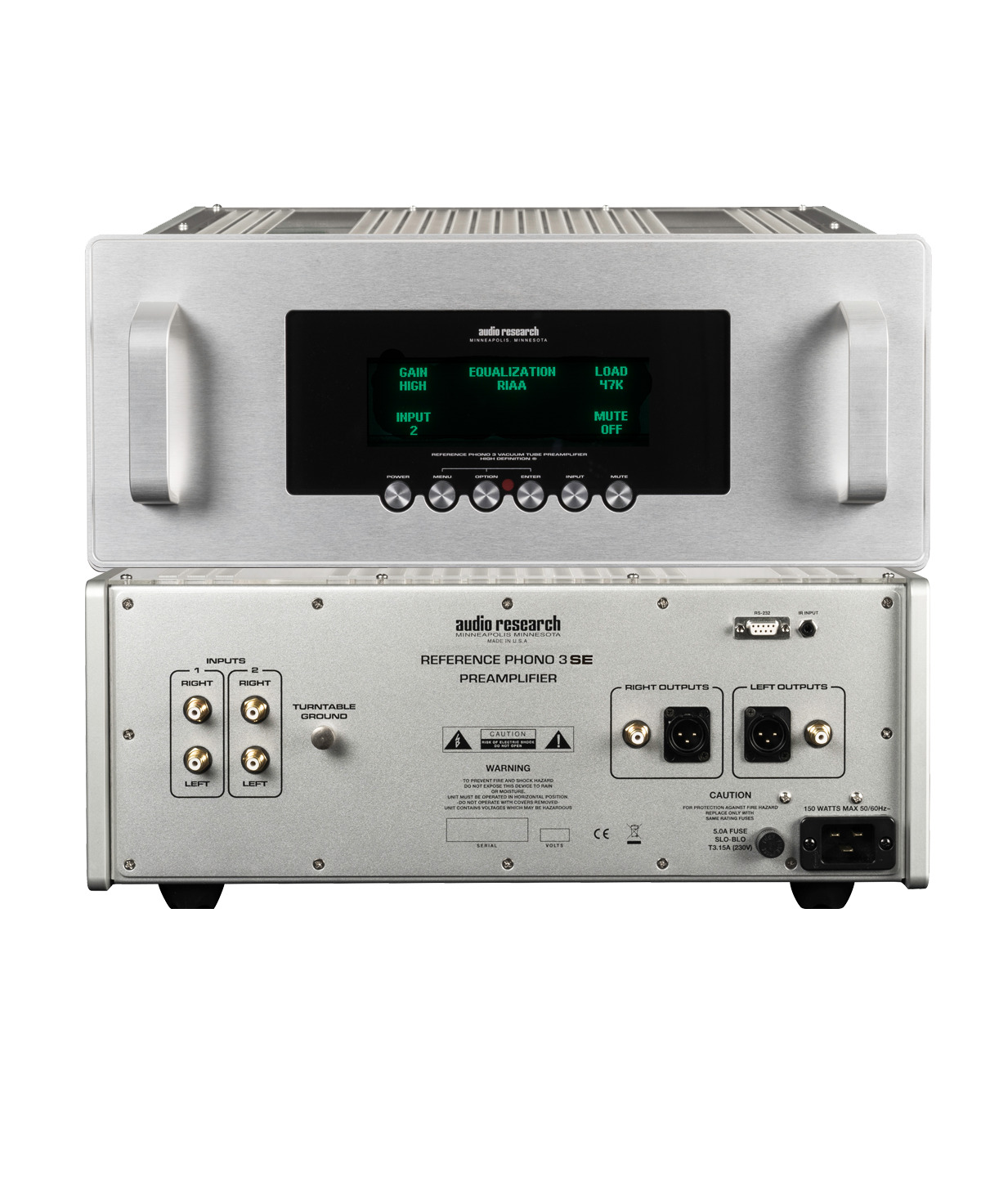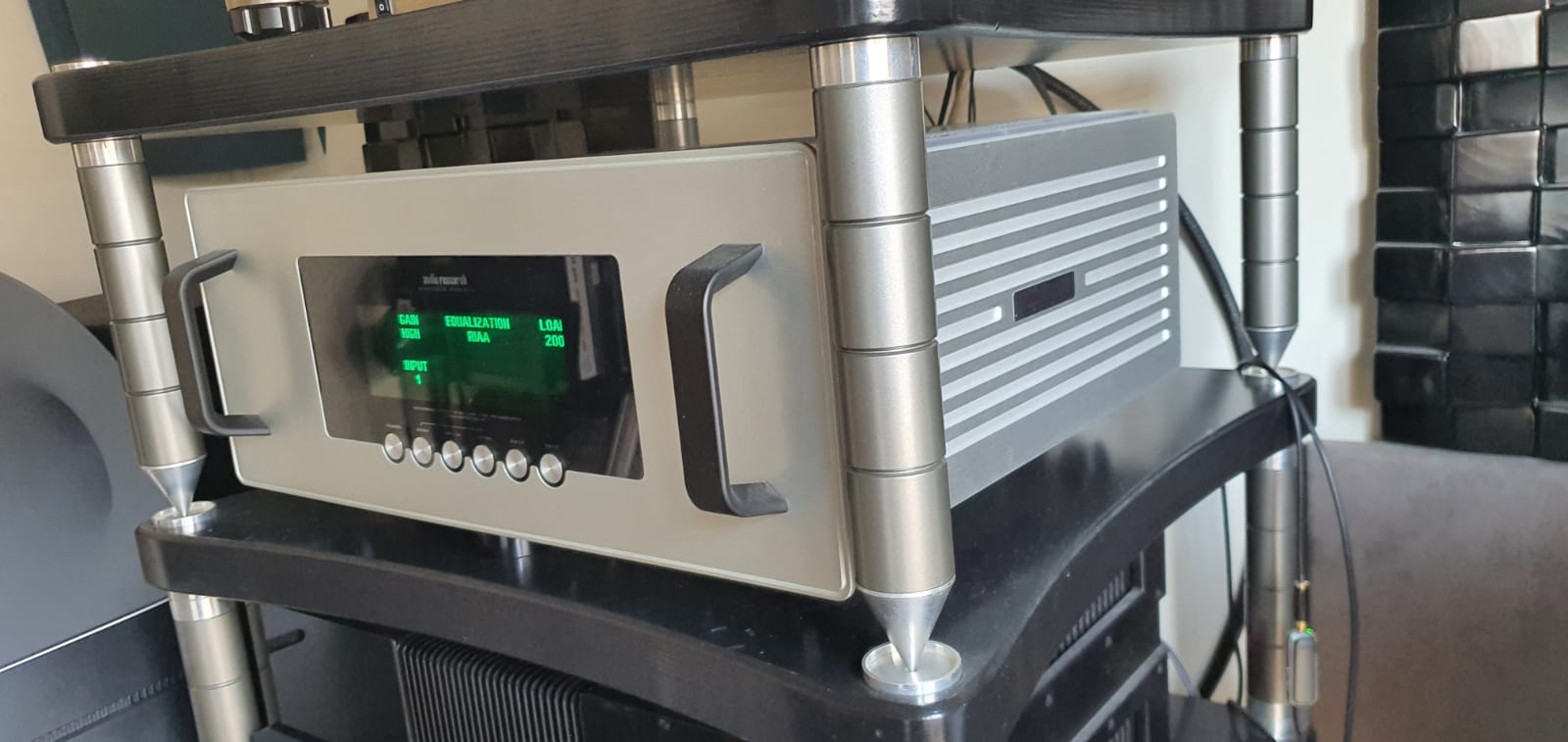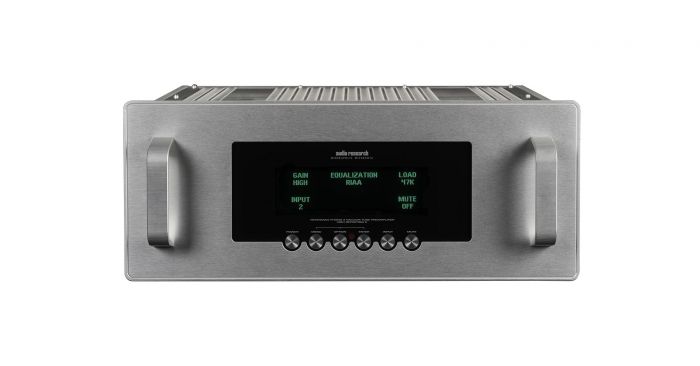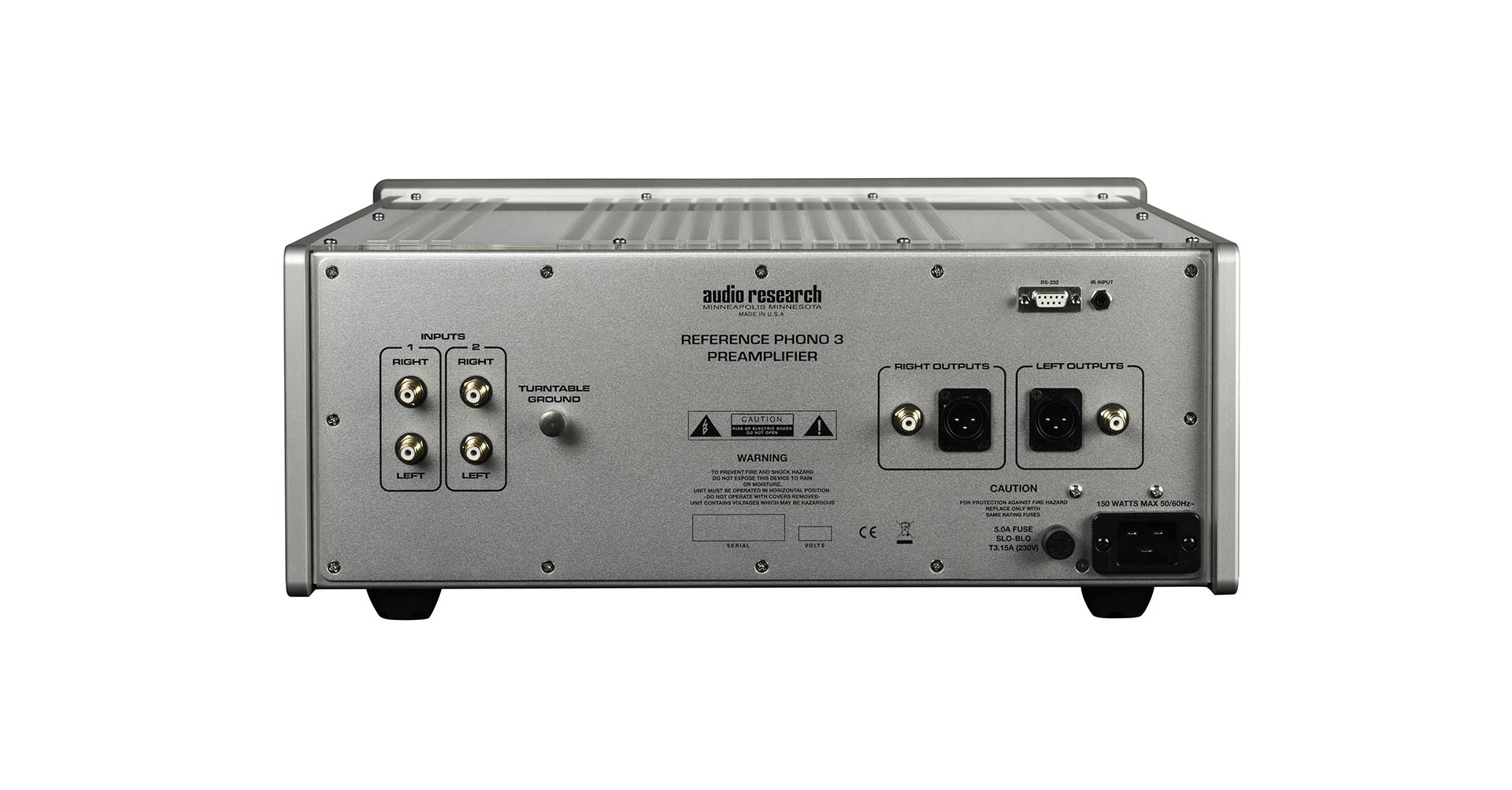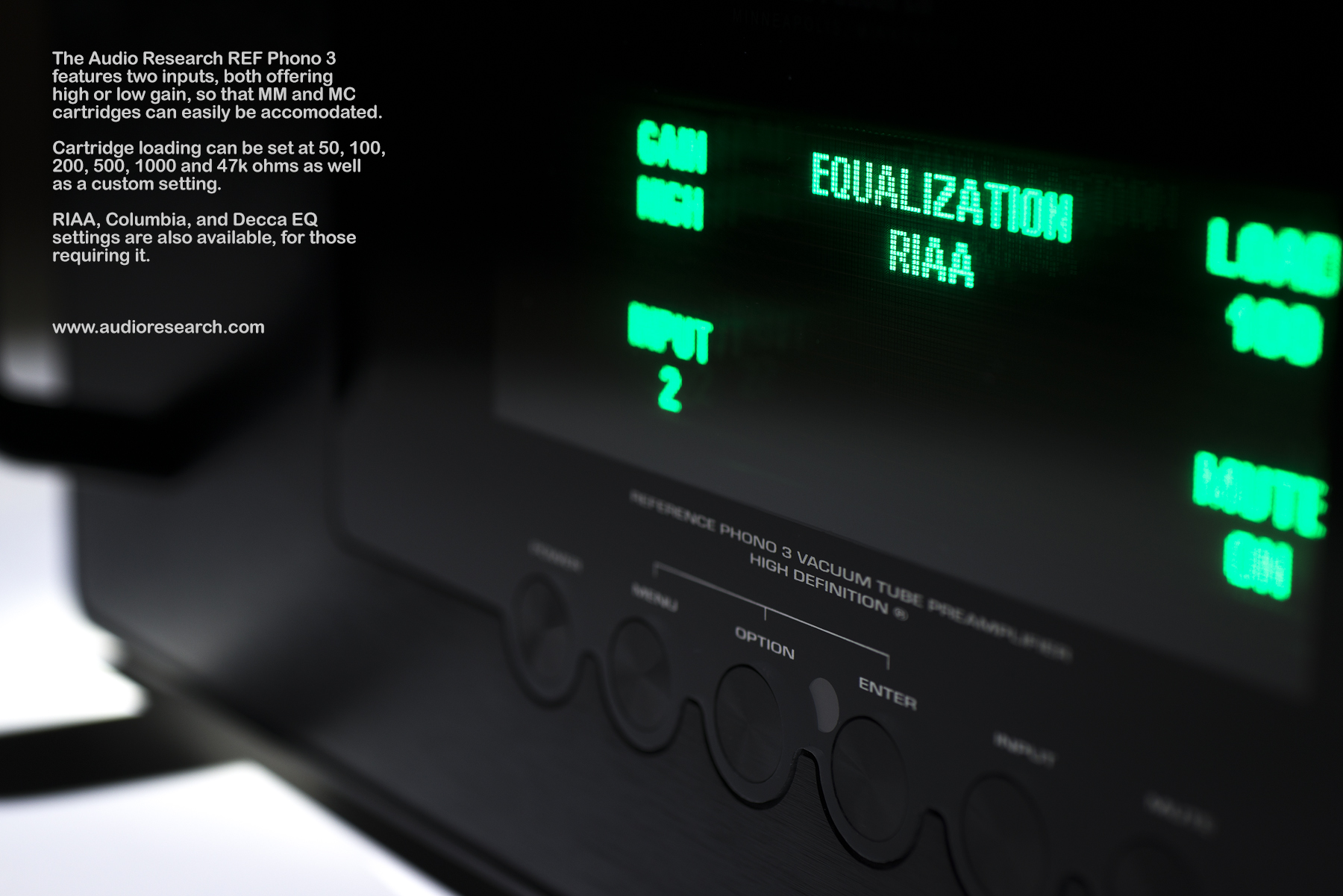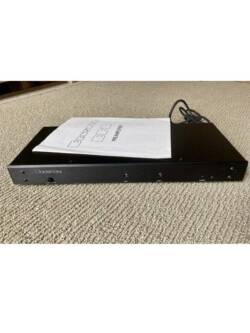Audio Research REF Phono 3 – Silver
Original price was: R325,000.00.R150,000.00Current price is: R150,000.00.
Closer to the master tape
In the world of high end audio two of the most revered names in the industry are McIntosh and Audio Research. McIntosh, founded in 1949 by Frank McIntosh and Audio Research in 1970 by William (Bill) Johnson, represents two of the oldest U.S manufacturers still in operation. Their coveted and fiercely loyal customer base can only be matched by the loyalty of their employees, many of whom have been with the company for over 30 years Together, McIntosh and Audio Research are considered by many to be the two iconic audiophile powerhouses which symbolizes American industrialism of the post-war era, with innovation that continues well into today’s postmodern age. In 2014, the CEO and COO of the Fine Sounds Group engaged in a management buyout of the Fine Sounds Group (which Audio Research was a part of), putting the two names under the same parent company formally known as the McIntosh Group.

Reference 3 in the mix.
While McIntosh is most famous for their amplifiers featuring the Unity Coupled Transformer circuitry, Audio Research is known for having some of the best preamps in the industry. This brings back memories of my younger days where I lusted after the iconic SP-11 hybrid preamp. Now that they have become affordable for me, I have been fortunate enough to lay my hands on some of the more recent designs such as the Reference 5 Preamp, the 40th Anniversary Preamp, and the Reference Phono 2 SE. These, together with every analog product produced since 2005, are designed by Ward Fiebiger, Senior Design Engineer of Audio Research. Ward has a career at Audio Research which spanned 37 years, many of which he spent working side-by-side company founder Bill Johnson, absorbing much of his design principles. Unfortunately, the audio industry suffered a great loss when Fiebiger died of a heart attack in March of 2017. The Reference Phono 3, the subject of our review today, is one of his last designs

Reference Phono 2SE (left floor) and Reference Phono 3 (right centre).
The Ref Phono 3 is a major evolutionary change from its predecessor, the Ref Phono 2SE. According to Dave Gordon of Audio Research, the design goal of the Ref Phono 3 is to improve further upon the foundation well established by the Ref 2SE, namely transparency, holographic sound staging, micro and macro dynamics, contrast, weight, authority and organic presentation In other words, they wanted a playback experience as close to the master tape as possible.
The Ref Phono 3 begins by sporting a new look which is in line with the company’s redesigned product image envisioned by Livio Cucuzza, the chief industrial designer for the entire McIntosh Group. Cucuzza combined elements of Audio Research’s traditional industrial image, and revitalized it with just the right amount of modern jolt. The front panel employs a larger screen and bigger buttons, but the sexiest improvement is with the new grooved aluminum side panels which replaces the plain steel chassis of the Ref Phono 2. The Reference Phono 3 retains the laser cut acrylic top of the Reference Phono 2, changing only from a smoky colour to completely transparent. Apparently the acrylic top cover is not just to show off the workmanship, but is apparently sonically superior than a metal cover. For same reason, the bottom cover of the Reference Phono 3 has now been changed to acrylic, though the metal cover will be available as a customer option upon request
The beef, however, lies under the hood. The Ref 3 Phono accepts 2 RCA inputs. Like the Reference Phono 2, the Ref Phono 3 uses JFET transistors at the input stage to keep noise down, which then feeds two gain stages and a cathode follower that acts as a buffer, reducing output impedance and allowing the Ref Phono 3 to drive long cables. The low gain stage produces 45dB of gain on the RCA output, and 51 dB on XLR, and the high gain section produces an additional 22 dB, which gives a combined total of 67 dB/73 dB on RCA/XLR outputs. That’s enough to accommodate very low output cartridges. In my setup, the Ref 3 Phono drove the 0.2+ mV output My Sonic Lab Ultra Eminent BC ultra-low impedance cartridge to my complete satisfaction, with minimal amount of noise and no hum issues whatsoever.

Tube count in the analog section has increased from four to six high current 6H30s, while maintaining a single 6H30 and a 6550 tube for power supply regulation. The power supply has been redesigned and grown to accommodate the additional tubes and to provide better dynamics. Many other components and parts, including proprietary coupling capacitors, wiring, transformer, and cryogenically treated pieces all contribute to the improvements.

Internals: Reference Phono 2 (left) vs Reference Phono 3 (right)
 Those familiar with Audio Research Reference level products will notice the 20 amp IEC inlet which requires a 20 amp power supply cable. Although none of the Reference front-end equipment use currents remotely close to 15 amps, Audio Research chose to use the 20 Amp inlet because it provides more of a snug fit. It also benefits from the lower gauge wire employed in the stock 20 amp cable However, when it comes to swapping cables it is a bit of a nuisance as most power cords come with 15A IEC connectors. I do prefer the sound of the Furutech Alpha 3 over the stock power cord, but instead of shelling out nearly $200 USD for a Furutech 20A IEC plug, I decided to opt for a cheaper solution by buying a $4 USD adapter on ebay. Do a search on ebay with the words BACK PDU WA-0089 IEC 320 C14 to C19 ADAPTER and you will find plenty on the cheap
Those familiar with Audio Research Reference level products will notice the 20 amp IEC inlet which requires a 20 amp power supply cable. Although none of the Reference front-end equipment use currents remotely close to 15 amps, Audio Research chose to use the 20 Amp inlet because it provides more of a snug fit. It also benefits from the lower gauge wire employed in the stock 20 amp cable However, when it comes to swapping cables it is a bit of a nuisance as most power cords come with 15A IEC connectors. I do prefer the sound of the Furutech Alpha 3 over the stock power cord, but instead of shelling out nearly $200 USD for a Furutech 20A IEC plug, I decided to opt for a cheaper solution by buying a $4 USD adapter on ebay. Do a search on ebay with the words BACK PDU WA-0089 IEC 320 C14 to C19 ADAPTER and you will find plenty on the cheap
$200 USD 20A IEC plug (left) vs $4 USD ebay adaptor.
Press the Power button on the front panel or the remote control, and an automatic two-minute warm-up timer will commence with the unit in MUTE ON mode Operation of the Ref Phono 3 is identical to the Ref Phono 2 and requires nothing other than common sense I navigated through its menu structure with the front panel buttons without even reading the user manual. You can also control all the functions of the Ref Phono 3 with its remote control, which has gone from plastic on the Ref Phono 2 to metal on the Ref Phono 3. The Ref Phono 3 remote will also work on the Ref Phono 2. Just like the Ref Phono 2, you can adjust gain, loading (50, 100, 200, 500, 1000 and Custom), and equalization curves on the fly (RIAA, Decca and Columbia).
The Ref Phono 3 has a built-in counter to monitor the total number hours the tubes have been in use. The 6H30s are expected to last a minimum of 4,000 hours, and the 6550 approximately 2,000, although in my Ref Phono 2SE, the 6H30s showed no signs of weakness even at 5,000 hours. A complete set of replacement tubes can be ordered for $650 and the 6550 at $90; albeit more expensive than the usual tube dealer, Audio Research burns-in and carefully grades all tubes for noise, micro-phonics, grid current and other quality control measures. Only after a tube successfully passed rigorous testing is it labeled and put into stock to be used in a product, those which failed are rejected to the supplier or disposed of. Ordinary vendors may not have the financial or technical means to conduct the necessary tests required, it is therefore strongly recommended that replacements be obtained from Audio Research.
Now comes the important part – the sound.
Over the course of three months, the majority of the listening was done with a My Sonic Lab Ultra Eminent BC cartridge mounted with a Reed 3P tonearm, on a JC Verdier La Platine Vintage turntable. But to be sure of the unit’s sonic characteristics, I did play with four different cartridges and tonearm combinations with two different turntables, comparing it side-by-side with the Ref Phono 2SE
As soon as the needle was dropped onto Charbier’s famous España – Rhapsody for Orchestra track (DECCA SXL 2020 ED1- España, Argenta conducting the LSO), it was obvious that the Ref Phono 3 carries the Audio Research house sound. The tonality of the Reference Phono 3 is nearly identical to the Ref Phono 2SE, it is remarkably neutral for a tube phono stage with a complete absence of coloration. It renders whatever you feed into it with accuracy, and without ever inducing any artificial tube warmth, nor does it veer towards the far end of the spectrum where the sound becomes analytical and sterile. What I wasn’t prepared for, was the dramatic change in sound staging, frequency extension and dynamic contrast which the Ref Phono 3 exhibited over the Ref Phono 2. On the España album, which is one of the most representative albums for demonstrating the wide dynamic range of the Decca sound (applicable to the original pressing and less on the Speaker’s Corner reissue), the Ref Phono 3 pushed the sound stage outward and beyond that of the Ref Phono 2 by a wide margin. So much so, that the locations of the mass strings, the trumpets, and the trombones which was within the confines of the speakers, have been extended deeper and wider into the acoustic space. The same can be said of the frequency extension which has been lifted and extended at both extremes, so much that the sonic colours of the holographic image became more vibrant, with deeper contrast.

Can it really be that much better than the Ref Phono 2? So much so, that I questioned whether the tubes in my Ref Phono 2 have reached the end of their lifespan and become flat sounding I decided to test all the tubes in my Amplitrex 2000 tester and to my surprise, they all measured close to 100%. David Gordon said the Ref Phono 3 measures exactly the same as the Ref Phono 2 on the bench, so it goes to show not all audible improvements can be measured. So whatever magical potion they have injected into the Ref Phono 3 seems to be working.
The Ref Phono 3 flexed its muscles once again when I played Richter’s performance of Liszt’s Piano Concerto No. 1 & 2 on Philips (PHS 900-000) If you do not yet own this album please do yourself a favour and pick up an original FR-1 on ebay rather than the Speaker’s Corner version. Even though it says Philips on the label, it is actually a Mercury production of Richter’s first ever recording at the Walthamstow Town Hall in the UK, using 35mm film for the recording instead of magnetic tape. Richter’s breathtaking performance delivered through the Mercury “Living Presence” sound poses great challenges for lesser equipment To reproduce the sound of a full size concert piano with all its dynamic spectrum is difficult enough, but to render the thunderous lower notes with clarity and distinction, is what made the Ref Phono 3 stand out vs. the Ref Phono 2, which in itself is already a phono stage difficult to beat. On the Ref Phono 3, not once did the lower notes of the piano got muddled together with the mass strings in the background. The image of the piano is solid, vivid and convincingly real. If Richter was alive and heard his own performance, I am sure it would have made him proud.
If climax has not been reached, Henry Lai’s original soundtrack for the movie Three Kingdoms – Resurrection Of The Dragon will do the trick. The soundtrack is a tour de force production of epic proportions not for the faint of heart. Lai brings together musicians from Beijing, Hong Kong, the Czech Capelien Orchestra and the Wang Hung Childrens Choir, combining western and Asian orchestral instruments together with Japanese Taiko drums, all in a melancholic yet dramatic musical score. From thundering drum attacks portraying scenes of battle, to slow melodious soprano tunes reflecting resiliency of the human spirit in a time of war. The serial-numbered album is a must buy for film score fans. On the thunderous taiko drums of the opening sequence in “The Five Generals”, I have always preferred the sound of the Burmester Phono 100 versus the Ref Phono 2, which renders better dynamic contrast and bass impact. But with the Ref Phono 3, the Burmester has met its match, the bass is deep, solid, rhythmic and tuneful. Yet on the slow movement “Resurrection of the Dragon” the voice of the soprano is projected deep into the soundstage with enough ambience surrounding her voice to move me to tears, clearly having the better top end extensions than both the Ref Phono 2 and Burmester Phono 100, almost reminding me of the Tenor Phono 1 which is four times the price.
But If Asian music is not your thing, then Hans Zimmer’s “Man of Steel” original soundtrack will deliver just as much dynamism as the The Three Kingdoms has to offer Ever wondered what 12 drummers playing simultaneously in a concentric circle in a space designed for a symphonic orchestra will sound like? Not too many systems can reproduce the 3D-holographic liveliness of 12 drummers surrounding you with just two channels and I can assure you the Ref Phono 3 will never be the bottleneck in a system because it rendered the holographic imagery with flying colours, with enough resolution and orderly detail so that each drums can be pinpointed and located amidst a very intense and complex performance.

How does the Ref Phono 3 sound with calmer music? I pulled out the Deutsch Grammophon reissue of Enrico Mainardi’s Violoncello mono album (19054 LPEM) featuring Schumann, Grazioli, Paradis, Gluck, Schubert and Chopin. Credit must be given to Deutsch Grammophon for coming out with many high quality reissues which I often find to be on par, or better quality than the originals. But regardless of quality the original wouldn’t have been affordable as they are going for nearly $2,000 USD on ebay. Playing old mono recordings is where tonal neutrality and accuracy will be appreciated more than coloration or artificial warmth. The resolution of the recording is not high to begin with, yet Mainardi’s cello is portrayed clearly in the acoustic space with a distinctive piano backdrop, with enough texture and decay on both the piano and the cello to fully convey the emotions of Mainardi’s mastery.
What about human voices? One thing which I didn’t lack on this review is due diligence as I played more than 60 albums with human voices over many bottles of fine Bartolo Mascarello Barolos. There are a few which stood out: Mercedes Sosa’s Gracias a la vida in her “30 Años” album is an emotionally charged performance which is even better than her duet with Joan Baez’s in the Diamond and Rust in the Bullring album. The same can be said of Daughter’s song Tomorrow, in the “4AD Session” album, or Volcano Choir’s Byegone in the “Repave” album. A common trait which the Ref Phono 3 displayed is the unmitigated realistic portrayal of human voices, it will convey the good with the bad embedded in the recording If you are looking for artificial tube warmth, perhaps consider the McIntosh MP1100 (review HERE), or the Kondo GE-1. With the Ref Phono 3 you will hear every breath, every incorrect note and imperfection in uncanny detail. I’ll also add that when it comes to human voices, I much prefer the sound of the My Sonic Lab BC cartridge over the Goldfinger Statement and the ZYX Universe Premium when paired with the Ref Phono 3, which means proper cartridge matching is essential.

At the end of the review exercise, the only thing which I disliked about the Ref Phono 3 is the lack of an industry standard 5-12V ON/OFF remote trigger. Audio Research has this feature on all their products except phono stages as they feel vinyl is not the most common source. They also do not think it is necessary to have a phono stage powered up every time a system is turned on as to conserve tube hours. For a person with nine tonearms and five phono stages, it is a bit of a nuisance to have to turn them on or off one by one. This, however, is not big enough an issue to deter me from buying the review sample. At $ 14,000 USD, the Ref Phono 3 only cost $1,000 USD more than the Ref Phono 2SE and at this price point I cannot think of too many contenders which come close to the performance of the Ref Phono 3. It is certainly a reference level product which deserves my unequivocal recommendation.
Here’s the thing. There are some who take the whole ‘user adjustable EQ curves’ aspect as intrinsic to a good phono stage. There are some who insist on absolute adjustability of cartridge loading as key to good phono reproduction. There are some who demand a low noise floor from their benchmark phono stages. Even in high-end audio’s thermosphere (the one beyond the one beyond the stratosphere, populated by aurora, meteorites, and ballistic missiles), typically you might have to make do with a ‘two out of three ain’t bad’ approach to phono stage design. The Reference Phono 3 is that rare exception that ticks all the boxes: it is quiet, it is almost infinitely adjustable, and it does come with a profusion of EQ options. However, what makes the Reference Phono 3 really shine is that if you are simply a ‘fit and forget’ kind of listener, who will never delve deep into listening out for the optimum loading for each channel of a cartridge, and who will never, ever play anything other than the standard RIAA curve, the Reference Phono 3 still has much to offer, in sound quality terms.

The term ‘reference’ still has meaning for Audio Research, and it doesn’t use the term lightly. The Reference Phono 3 is a true reference point in turntable replay, as it extracts a remarkable amount of information from the cartridge, and yet plays it in a manner that invites you to listen to more and more albums. Those hundreds of hours of run-in will never be viewed as a chore, more as a pleasure, unveiling both what your records are capable of and just how much better your Reference Phono 3 gets. And those hundreds of hours will pass quickly, too. From a position of not firing the ejector seat on my own career at least, there can be no ‘best’ in high-end audio, but the Audio Research Reference Phono 3 is one of those rare devices that gets closer to ‘best’ than most. Highly recommended.
Description
Technical Specifications
Type: Hybrid phono stage
Tube Complement: (6)-6H30P dual triodes, plus (1 each) 6550WE and 6H30P in power supply
Controls: Six Push Buttons: Power, Menu, Option, Enter, Input, Mute
Inputs: 2× RCA stereo pair, earth tag, RS232 comms
Outputs: Balanced XLR pair, single‑ended RCA pair
Frequency Response: ±.2 dB of RIAA, 10 Hz to 60kHz; 3 dB points below 0.3Hz and above 300 kHz
Distortion: Less than .002% at 1.0V RMS 1kHz output
Gain: Selectable 51 dB (Low) and 73 dB (High) at 1kHz BAL; 45 dB (Low) and 67 dB (High) at 1kHz SE. (MC and MM compatible)
Input Impedance: 47k Ohms and 100 pF SE. Selectable loads: 1000, 500, 200, 100, 50 Ohms, and Custom
Output Impedance: 400 ohms Balanced, 200 ohms SE. Recommended load 50k-100k Ohms and 100 pF. (10k Ohms minimum and 2000 pF maximum)
Phono Equalization: (selectable) RIAA, Columbia, and Decca
Dimensions (W×H×D): 48×19.8×41.9cm. Handles extend 4 cm forward of the front panel
Weight: 16.6 kg
Price: £11,998
Manufactured by: Audio Research Corporation
